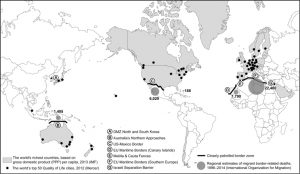Where is inequality? Like all things for which we lack, or have lost, a working vocabulary, this question sounds strange tripping off the tongue. But really it shouldn’t. Inequality is of course many things, and certainly it is more than income inequality alone. For the French historian Pierre Rosanvallon, it is nothing less than the measure and the motor of our present democratic malaise: “the stealthy blade that is silently severing the social bond and simultaneously undermining social solidarity.”1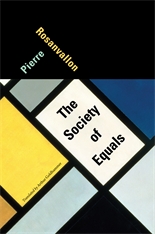 Harvard University Press, 2013.More Info → But even such a relatively expansive account of inequality as Rosanvallon provides immediately begs the question of which solidary community is at stake or ostensibly under threat. Who is the “we” here? Is the problem of inequality really contained fully within national frontiers? And if not, to what extent does the longstanding need to address international inequality warrant attention alongside the historically more recent need to tackle inequality domestically?
Harvard University Press, 2013.More Info → But even such a relatively expansive account of inequality as Rosanvallon provides immediately begs the question of which solidary community is at stake or ostensibly under threat. Who is the “we” here? Is the problem of inequality really contained fully within national frontiers? And if not, to what extent does the longstanding need to address international inequality warrant attention alongside the historically more recent need to tackle inequality domestically?
These were questions I tried to address in my 2015 book, The Political Origins of Inequality.2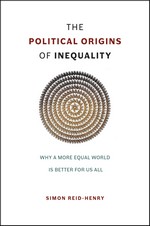 University of Chicago Press, 2016.More Info → Such questions were once commonplace to consider. In a paper first delivered to the University of Chicago in 1954, the American economist Simon Kuznets held (while acknowledging the then “scanty” statistical picture) that when the gap between nations was spectacular—when “only the barest contact between them [was] possible” (Kuznets 1965, p. 173) privileged societies could go about their business without any undue concern for what was happening elsewhere; it was when that gap began to close that international inequality took on a more overtly political character.3 In Simon Kuznets, “Regional Economic Trends and Levels of Living,” in Economic Growth and Structure: Selected Essays (New York: Norton, 1965 [1958]), see pp. 173–74. Kuznets also added an insight regarding the “underdeveloped” countries that would today strike perhaps more of a note in the “developed” countries: “Under … conditions of growth and internal mobility, wide income differentials within a country are much more acceptable than under conditions of slow growth or stagnancy…” (p. 157). When wealthy Indians, say, could compare themselves to poor Americans (Kuznets himself flagged the USSR as a more loaded example), and above all when those same Americans looked over their shoulder to the fast-approaching Indians, that was when inequality became political. In a different vein, and partly because he recognized that inequality did not just turn political but was political from the outset, Gunnar Myrdal spent much of the same decade arguing, in lectures given in America, Egypt, and Australia, for what he termed a “welfare world.”4
University of Chicago Press, 2016.More Info → Such questions were once commonplace to consider. In a paper first delivered to the University of Chicago in 1954, the American economist Simon Kuznets held (while acknowledging the then “scanty” statistical picture) that when the gap between nations was spectacular—when “only the barest contact between them [was] possible” (Kuznets 1965, p. 173) privileged societies could go about their business without any undue concern for what was happening elsewhere; it was when that gap began to close that international inequality took on a more overtly political character.3 In Simon Kuznets, “Regional Economic Trends and Levels of Living,” in Economic Growth and Structure: Selected Essays (New York: Norton, 1965 [1958]), see pp. 173–74. Kuznets also added an insight regarding the “underdeveloped” countries that would today strike perhaps more of a note in the “developed” countries: “Under … conditions of growth and internal mobility, wide income differentials within a country are much more acceptable than under conditions of slow growth or stagnancy…” (p. 157). When wealthy Indians, say, could compare themselves to poor Americans (Kuznets himself flagged the USSR as a more loaded example), and above all when those same Americans looked over their shoulder to the fast-approaching Indians, that was when inequality became political. In a different vein, and partly because he recognized that inequality did not just turn political but was political from the outset, Gunnar Myrdal spent much of the same decade arguing, in lectures given in America, Egypt, and Australia, for what he termed a “welfare world.”4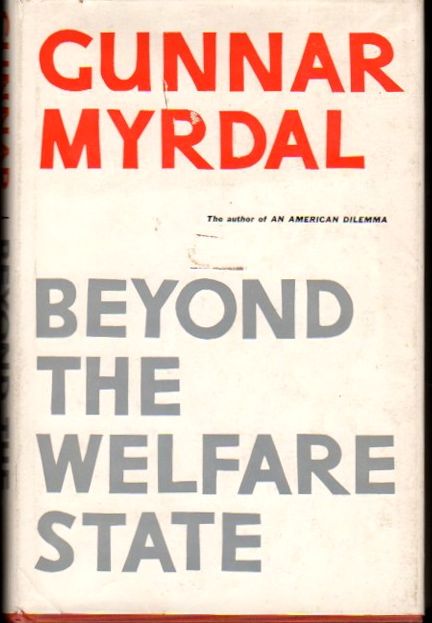 Yale University Press, 1960.More Info → Myrdal’s wife and coauthor, Alva, similarly used her own pulpit at the United Nations to call for “a more scientific approach to international welfare,” something with which Kuznets for one would have concurred.5 Alva Myrdal, Arthur J. Altmeyer, and Dean Rusk, America’s Role in International Social Welfare, The Florina Lasker Lectures (New York: Columbia University Press, 1955).
Yale University Press, 1960.More Info → Myrdal’s wife and coauthor, Alva, similarly used her own pulpit at the United Nations to call for “a more scientific approach to international welfare,” something with which Kuznets for one would have concurred.5 Alva Myrdal, Arthur J. Altmeyer, and Dean Rusk, America’s Role in International Social Welfare, The Florina Lasker Lectures (New York: Columbia University Press, 1955).
More Info →
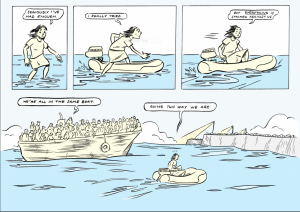
Illustrations by Esben Slaatrem Titland.
But all this was in the 1950s. After this point, Western nations busied themselves with building up their own welfare states domestically, while the gaps between nations were dealt with almost exclusively in terms of “international development.” For more than half a century the intellectual focus was thus geared (ostensibly at least) toward narrowing the development gap and teaching poor countries the art of living like the rich. And neither the historic return of inequality to the rich countries since around the 1980s nor the even more recent rediscovery of it as a critical (even politicized) vocabulary in social science have dislodged that fundamental worldview.
This goes some way to explaining why that recent recovery of inequality as part of our mainstream social scientific discourse has been no less selective than it has been dramatic (as Pedro Ramos Pinto reminds us earlier in this series). Thomas Piketty’s Capital in the Twenty-First Century6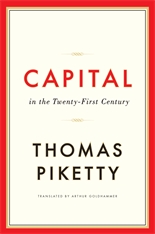 Harvard University Press, 2014.More Info → and Richard Wilkinson and Kate Picket’s The Spirit Level7
Harvard University Press, 2014.More Info → and Richard Wilkinson and Kate Picket’s The Spirit Level7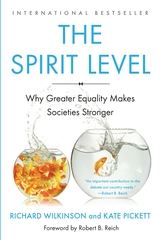 Bloomsbury Press, 2010.More Info →—the two indisputable peaks of the new literature on either side of the Atlantic—are each explicitly focused on within-country inequality. In many respects this makes sense. It is within-country inequalities that have been rising most dramatically in recent decades, including within the West. And it is inequality within the bounds of a given political community that is felt most acutely of all.
Bloomsbury Press, 2010.More Info →—the two indisputable peaks of the new literature on either side of the Atlantic—are each explicitly focused on within-country inequality. In many respects this makes sense. It is within-country inequalities that have been rising most dramatically in recent decades, including within the West. And it is inequality within the bounds of a given political community that is felt most acutely of all.
But still, globalization has bequeathed to us a world that is rapidly integrating, and the economic fortunes and misfortunes of national citizens are not made within domestic political economies alone. Bill Gates’s contribution to the position of the 0.0001 percent in America (the Forbes 400) is a product of his freedom both to accrue wealth internationally (via a globalized intellectual property rights regime) and to protect it internationally (via offshore tax loopholes). Scratch beneath the surface and the same issues that make inequality such a hot political topic here—the decline of social mobility say—also apply globally. At the end of the Cold War one in four of the world’s inhabitants lived somewhere with an improving standard of living. Today that same figure has fallen to one in six. 8 Cambridge University Press, 2007.More Info →The present challenge of mass migration is hardly unrelated to this fact.
Cambridge University Press, 2007.More Info →The present challenge of mass migration is hardly unrelated to this fact.
There is a geography to the politics of inequality, therefore, and there are histories to the making of that geography that we can—and should—uncover. For while geography is still routinely ignored in intellectual critique it is very much taken into account at every bordered wall that is currently being thrown up to keep migrants and asylum seekers out of the West (see map below). To focus the debate on inequality at the domestic level alone thus leaves a number of important aspects unaddressed. First, it overlooks the extent to which social polarization domestically is produced in part through the workings of an international political economy. Second, it obscures the way in which a wider culture of tolerance for inequality in countries like Britain and America has, during the past few decades, been both nourished and amplified on the back of a wider tolerance of poverty and suffering globally. This is what the age of humanitarianism bequeaths to the age of inequality.
What we confront, therefore, is an epistemological as well as a practical disconnect in the way that we treat inequality at the national and the international scale. For whereas discussion of inequality at the national level latches firmly onto wealth as the problem, the preferred mode of analysis of international development is to focus almost exclusively on the poor, be it the mantra of “poverty reduction” or yet grander schemes to “end poverty in our lifetime.” And in both cases, the dynamic aspect of the problem—the “structure” of inequality we might say—remains hidden from view.
The poverty of elsewhere?
There is indeed a need then, as Susan Sontag once said, for greater reflection as to “how our privileges are located on the same map as their suffering.”9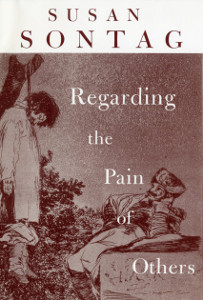 FSG, 2003.More Info → But what does that mean in practice? Let me offer two brief examples by way of illustration. It means for one that we need think relationally in terms of class, as Mike Savage and Niall Cunningham point out in their contribution to this set of essays. The Occupy movement has drawn attention to the unfair share of wealth held by the top 1 percent of income earners in rich nations, for example. Yet as was often pointed out, a good few of those protesting in New York’s Zuccotti Park in 2011 were themselves a part of the global 1 percent (defined at the time as anyone with an average income of $34,000 or more).
FSG, 2003.More Info → But what does that mean in practice? Let me offer two brief examples by way of illustration. It means for one that we need think relationally in terms of class, as Mike Savage and Niall Cunningham point out in their contribution to this set of essays. The Occupy movement has drawn attention to the unfair share of wealth held by the top 1 percent of income earners in rich nations, for example. Yet as was often pointed out, a good few of those protesting in New York’s Zuccotti Park in 2011 were themselves a part of the global 1 percent (defined at the time as anyone with an average income of $34,000 or more).
Given that the geography of the global 1 percent remains a strongly Western one still, that is hardly surprising. But it is significant nonetheless. Of the 60 million persons who make up the global 1 percent, 30 million are Americans who make up the top 12 percent of their own income distribution.10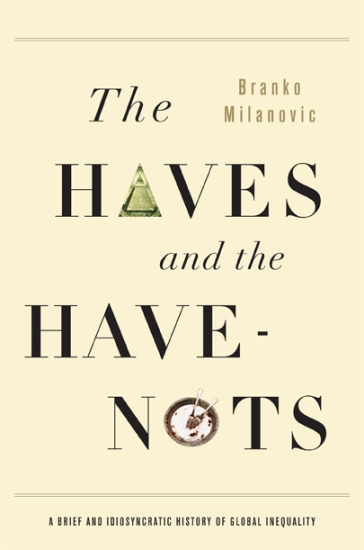 Basic Books, 2012.More Info →
Basic Books, 2012.More Info →
p. 169. There they use their wealth and influence to shape policies that serve them not only at home but abroad too. Consider just the impact of the US cotton lobby, via trade subsidies, on international prices and ultimately on incomes in a country like Mali (the removal of which, Oxfam calculates, would boost incomes in West Africa by 9 percent).11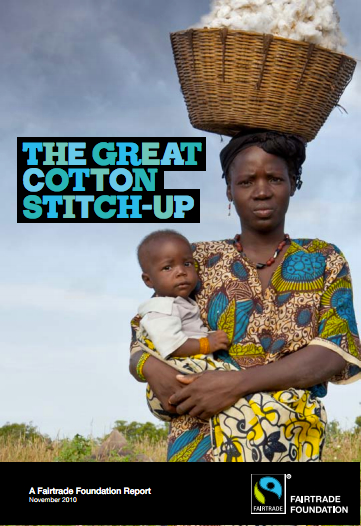 Fairtrade Foundation, Nov. 2010.Read online →
Fairtrade Foundation, Nov. 2010.Read online →
Leading the way among those asking new and important questions here is former World Bank economist Branko Milanovic, from whom the above definition of the global 1 percent is derived. Drawing on carefully assembled household-level data, Milanovic breaks down the various scales of inequality and reassembles them into a picture of the dynamic interplay between them. The effect of this can best be captured by the idea of what he calls “citizenship rents”—the aggregate of benefits that accrue to individuals based upon their location rather than their class.12 Harvard University Press, 2016.More info → Gerry Kearns and I refer to this same phenomenon as “geographical luck.”13 Gerry Kearns and Simon Reid-Henry, “Vital Geographies: Life, Luck and the Human Condition” (2009), Annals of the Association of American Geographers, 99(3): pp.554-574. Being born somewhere with diminished opportunities is one thing at a time of rising wealth. At a time of declining social mobility nationally it is quite another.
Harvard University Press, 2016.More info → Gerry Kearns and I refer to this same phenomenon as “geographical luck.”13 Gerry Kearns and Simon Reid-Henry, “Vital Geographies: Life, Luck and the Human Condition” (2009), Annals of the Association of American Geographers, 99(3): pp.554-574. Being born somewhere with diminished opportunities is one thing at a time of rising wealth. At a time of declining social mobility nationally it is quite another.
But we also need to think about the ways that structural inequalities are embedded within and across the wider political landscape, not just at the fracture points of city limits and national borders. In 2013 one of the hottest reported zones of MDR tuberculosis was indeed the US-Mexico border, for example: a reminder, as director of the CDC Thomas Frieden put it, that “we’re all connected by the air we breathe.”14Read online →
p. 169. But it might also have served as a reminder that we are all connected by the political systems we live in. Just four years earlier, when Swine Flu hit Mexico, it turned out to be a function not of Mexican hygiene standards but of American-owned combined animal-feeding operations (CAFOs), which had relocated South of the border to capitalize on lower wages.15 Far from the Mexican Flu it was stereotypically branded in the media, it would have been more accurately termed “NAFTA Flu.”
See Matthew Sparke and Dimitar Anguelov, “H1N1, Globalization and the Epidemiology of Inequality,” Health and Place 18 (2012): 726-36.
Global inequality (and its discontents)
Global health—and the uneven global burden of health more generally—is a good example of the fact that inequality concerns much more than income distribution alone. But uncovering this larger picture requires more attentive histories of the making of global inequality than can be obtained when our focus at the international level is constrained by a debate about the relative merits and demerits of globalization on the one hand and the successes and failures of international development on the other. A few lone voices have long beaten this path.16 One thinks, for example, of the work of Robert Wade for many years at the LSE, or of the UNRISD in Geneva and UNU-WIDER in Helsinki. But it is an area that is only now just beginning to properly come of age in the work of a younger generation of political scientists, historians, and geographers.17 For example, see the results of The Road to Global Inequality, 1945-Present Day: New Historical Perspectives conference or the recent Humanity special issue “Toward a History of the New International Economic Order”
Such work is addressing, for example, why the twentieth-century project of national equality never successfully transferred to the global scale. That it didn’t may seem self-evident today. But as we saw above, things looked different from the point of view of the more social democratic midcentury. Gunnar Myrdal is an illuminating case in point here. Despite his strongest conviction, in the 1950s, that the extension of the Western welfare state to the scale of the world was inevitable, by the time of the publication of his last major work on international economics in 1970, The Challenge of World Poverty,18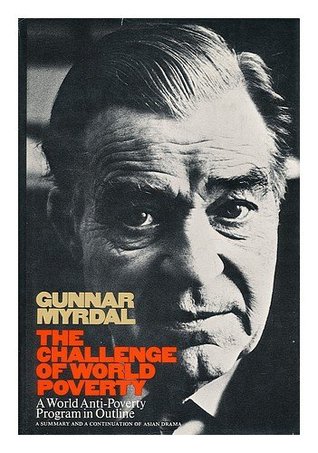 Pantheon Books, 1970.More info → he was already, as the title alluded, on his way to thinking within the terms of absolute poverty, not relational inequality. Why?
Pantheon Books, 1970.More info → he was already, as the title alluded, on his way to thinking within the terms of absolute poverty, not relational inequality. Why?
In part Myrdal had simply come to believe that the consolidation of the Western welfare state had itself become the greatest barrier to international solidarity. But above all he now recognized the full scale of the entanglements of geopolitics and international hegemony (specifically the role of the United States) in matters of international economy. And so he felt, accordingly, that the better part of valor increasingly lay with trying to coax the United States into a more benign hegemonic mode: promoting peace not war in Vietnam, leading the way in matters of “international compassion and solidarity,” and championing the “development and welfare of the poor countries.”
As it happened, that was more or less everything that the United States was not about to do, beginning with its pushback against the non-aligned countries and their Myrdalian-type plans for a New International Economic Order (NIEO).19See the recent Humanity special issue “Toward a History of the New International Economic Order” on the NIEO. But the “victories” of those years set the scene for more than just the bifurcation of the globe into the neoliberal ordering of winners and losers, free-trade areas and failed states. As the always problematic (but at least interdependent) vocabulary of First, Second, and Third worlds was exchanged for the Brandtian tectonics of a global North and a global South, the scene was set too for the splicing apart of the Western concern with inequality at the global and national scales.
Ironically, of course, this was happening at the very moment that the prospects for the Western middle class began to slide downward, while those of the wealthiest citizens of the global South shot upwards. The insights of someone like Simon Kuznets were thus realized at the same moment the vocabulary for addressing those insights went out of fashion. Few paid this any attention, however. The Western left was by now busy turning to humanitarianism (at least that part of the New Left that sought political relevance) while the right was focused on its new project of political minimalism (for which the recent reemergence of human rights was on hand to assist).
“…there were moments when a politics of inequality was chosen.”Seen thus and the history of uneven global development can in many ways be retold as a history of the managed submergence of one set of ideas about global inequality beneath the more “doable” notion of global poverty. If this is a story that, from the 1970s onward, runs parallel to the history of neoliberalism, it is not containable within that period alone. The 1970s are far from the only critical moment in the social and political history of inequality. The “long 1940s,” in which notions of collective duty were dramatically reworked (prior to the breakthrough of human rights) provide another. And ultimately, of course, this is a story for which we must go back to the colonial encounter: “to the treasure which Drake stole from Spain,” as Keynes put it, and that Columbus and Cortes before him had relieved of the mines of Potosí and Montezuma.20 Harcourt, Brace & Co., 1932.More info → The main point, however, is that there were moments when a politics of inequality was chosen. And understanding those choices, as they were posed, and why they were responded to as they were, can help us make sense of our own choices today. Not least, they remind us how the return of inequality at home may be structurally connected to the prosperity we have for too long refused to share with the poor from elsewhere.
Harcourt, Brace & Co., 1932.More info → The main point, however, is that there were moments when a politics of inequality was chosen. And understanding those choices, as they were posed, and why they were responded to as they were, can help us make sense of our own choices today. Not least, they remind us how the return of inequality at home may be structurally connected to the prosperity we have for too long refused to share with the poor from elsewhere.
The global social question
So where does this leave us today? What is to be done? In one of his last published essays, the historian Tony Judt observed that the Western, and especially North-Atlantic, world is today experiencing a return of the great nineteenth-century social question: a “social question redividus” as he put it. For Judt that fact alone was a standing rebuke of Anglo-American liberal capitalism, and he looked primarily to the softer winds of social democracy to provide the lift that our collective sails required. Judt was, of course, too good a historian not to see the difficulties in this. Not least, any viable social democracy reinvented for the twenty-first century would have to unhitch itself from its twentieth-century reliance upon distributing the fruits of high growth: a project that was perhaps only ever tenable in the particular time and place of the Atlantic midcentury. But the anguish with which he observed the contemporary refusal to even try to imagine something better was almost palpable by the time of his last public lecture, which he accordingly titled “What Is Living and What Is Dead in Social Democracy?” 21Read online →
For Judt, whatever the solutions were to be, they lay necessarily still with the state. In certain respects he was right about this. Absent the forced leveling effects of war, disease, and revolution, inequality can only be addressed by coordinated public action. But Judt had a blind spot when it came to international society—indeed he would likely have snorted that there is no such thing. And yet had he been more attuned to geography, he might have glimpsed a way out of his own intellectual bind. For the Scandinavian countries he looked to for inspiration do not possess a monopoly on the social policy and political bargaining that form the core of the social democratic model. Much less does the past of our own countries provide the only relevant guide. Instead, when we bring the history of other places back into our story of inequality writ large, we find there is much to learn about policies oriented toward the democratic expansion of political and economic equality from places as diverse as Costa Rica or the Indian state of Kerala.22 See for example, Marc Edelman, Patrick Heller, and Judith Teichmark, Social Democracy in the Global Periphery: Origins, Challenges, Prospects (Cambridge University Press, 2007). In both of these cases social policy and democratic egalitarianism have proven effective means of inducing economic development.
“Either we push forward with social protection globally, or we will continue to see it fall apart.”But that too is only part of the story. The reality of our own times is that we confront not just a rerun of the old national social question but a whole new global social question. And I would end this commentary by suggesting that this is the single most important question that now falls to us first to pose properly, and then to try to solve. Doing so means addressing somehow the basic geographical tensions between the scope of political community and the reach of economic processes that Suresh Naidu identifies when he says that “[n]ational equality should not automatically be prioritized over international equality, but nor should the arenas where agents can exercise political voice be ignored.” Whether that be through efforts to democratize the international arena, or through greater cross-national coordination of taxation law, or even by replacing the current system of international aid with a form of global public spending, national-level policymaking ultimately has no choice but to look to the global scale if it is to effectively respond to a problem that is political in its origins and global in its scope.
In short, either we push forward with social protection globally, or we will continue to see it fall apart in the global North as much as in the global South. With multilateralism failing and liberal commitments to rights and freedoms long considered irreproachable beginning to falter, this is a choice we do not have all the time in the world to make.23Antonio Donini, “The Crisis of Multilateralism and the Future of Humanitarian Action,” IRIN, November 30, 2016.
Read online →
References:
More Info →
p. 169.
See Matthew Sparke and Dimitar Anguelov, “H1N1, Globalization and the Epidemiology of Inequality,” Health and Place 18 (2012): 726-36.
Read online →













